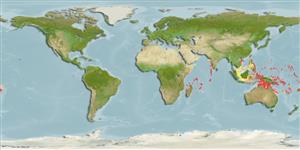Common names from other countries
Environment: milieu / climate zone / depth range / distribution range
Ecologia
marinhas associadas(os) a recifes; intervalo de profundidade 1 - 55 m (Ref. 27115), usually 1 - 35 m (Ref. 90102). Tropical; 22°C - 28°C (Ref. 27115); 19°N - 22°S
Indo-Pacific: Aldabra and Astove of Seychelles to the Loyalty Islands, Fiji and Japan. Report from southern Marshall Islands appears to be based on the paratype of Luzonichthys robustus Fourmanoir, which has been reidentified as Luzonichthys earlei (Ref. 8524).
Tamanho / Peso / Idade
Maturity: Lm ? range ? - ? cm
Max length : 7.0 cm TL macho/indeterminado; (Ref. 2334)
Espinhos dorsais (total) : 10; Raios dorsais (total) : 15 - 16; Espinhos anais: 3; Raios anais : 7. Looks blue with dark yellow over the back when seen in natural light. Unlike most other basslets, the dorsal fins are in two parts (Ref. 48635).
Usually in groups on outer reef slopes (Ref. 27115). Most commonly occurs in shallow water and most likely seen by divers (Ref. 37816). Forms dense aggregations that feed on zooplankton (Ref 90102).
Ciclo de vida ou comportamento de acasalamento
Maturities | Reprodução | Spawnings | Egg(s) | Fecundities | Larvas
Randall, J.E. and J.E. McCosker, 1992. Revision of the fish genus Luzonichthys (Perciformes: Serranidae: Anthiinae), with descriptions of two new species. Indo-Pac. Fish. (21):21 p. (Ref. 8524)
Status na Lista Vermelha da UICN (Ref. 130435)
CITES (Ref. 128078)
Not Evaluated
Ameaça para os humanos
Harmless
Uso pelos humanos
Pescarias: espécies comerciais; Aquário: Espécies comerciais
Ferramentas
Relatórios especiais
Baixar XML
Fontes da internet
Estimates based on models
Preferred temperature (Ref.
115969): 25.9 - 28.9, mean 27.7 (based on 604 cells).
Índice de diversidade filogenética (Ref.
82804): PD
50 = 0.5156 [Uniqueness, from 0.5 = low to 2.0 = high].
Nível Trófico (Ref.
69278): 3.4 ±0.45 se; based on food items.
Resiliência (Ref.
120179): Elevada, tempo mínimo de duplicação da população menor que 15 meses (Preliminary K or Fecundity.).
Fishing Vulnerability (Ref.
59153): Low vulnerability (10 of 100).
